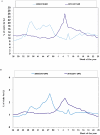Nationwide surveillance of influenza during the pandemic (2009-10) and post-pandemic (2010-11) periods in Taiwan
- PMID: 22545158
- PMCID: PMC3335813
- DOI: 10.1371/journal.pone.0036120
Nationwide surveillance of influenza during the pandemic (2009-10) and post-pandemic (2010-11) periods in Taiwan
Abstract
Introduction: Although WHO declared the world moving into the post-pandemic period on August 10, 2010, influenza A(H1N1) 2009 virus continued to circulate globally. Its impact was expected to continue during the 2010-11 influenza season. This study describes the nationwide surveillance findings of the pandemic and post-pandemic influenza periods in Taiwan and assesses the impact of influenza A(H1N1) 2009 during the post-pandemic period.
Methods: The Influenza Laboratory Surveillance Network consisted of 12 contract laboratories for collecting and testing samples with acute respiratory tract infections. Surveillance of emergency room visits and outpatient department visits for influenza-like illness (ILI) were conducted using the Real-Time Outbreak and Disease Surveillance system and the National Health Insurance program data, respectively. Hospitalized cases with severe complications and deaths were reported to the National Notifiable Disease Surveillance System.
Results: During the 2009-10 influenza season, pandemic A(H1N1) 2009 was the predominant circulating strain and caused 44 deaths. However, the 2010-11 influenza season began with A(H3N2) being the predominant circulating strain, changing to A(H1N1) 2009 in December 2010. Emergency room and outpatient department ILI surveillance displayed similar trends. By March 31, 2011, there were 1,751 cases of influenza with severe complications; 50.1% reported underlying diseases. Of the reported cases, 128 deaths were associated with influenza. Among these, 93 (72.6%) were influenza A(H1N1) 2009 and 30 (23.4%) A(H3N2). Compared to the pandemic period, during the immediate post-pandemic period, increased number of hospitalizations and deaths were observed, and the patients were consistently older.
Conclusions: Reemergence of influenza A(H1N1) 2009 during the 2010-11 influenza season had an intense activity with age distribution shift. To further mitigate the impact of future influenza epidemics, Taiwan must continue its multifaceted influenza surveillance systems, remain flexible with antiviral use policies, and revise the vaccine policies to include the population most at risk.
Conflict of interest statement
Figures





Similar articles
-
[Influenza surveillance in five consecutive seasons during post pandemic period: results from National Influenza Center, Turkey].Mikrobiyol Bul. 2016 Jul;50(3):401-17. doi: 10.5578/mb.27775. Mikrobiyol Bul. 2016. PMID: 27525396 Turkish.
-
Epidemiology of pandemic influenza A/H1N1 virus during 2009-2010 in Taiwan.Virus Res. 2013 Oct;177(1):46-54. doi: 10.1016/j.virusres.2013.07.007. Epub 2013 Jul 22. Virus Res. 2013. PMID: 23886669
-
Update: influenza activity--United States, 2010-11 season, and composition of the 2011-12 influenza vaccine.MMWR Morb Mortal Wkly Rep. 2011 Jun 3;60(21):705-12. MMWR Morb Mortal Wkly Rep. 2011. PMID: 21637185
-
Pandemic novel 2009 H1N1 influenza: what have we learned?Semin Respir Crit Care Med. 2011 Aug;32(4):393-9. doi: 10.1055/s-0031-1283279. Epub 2011 Aug 19. Semin Respir Crit Care Med. 2011. PMID: 21858744 Review.
-
Epidemiologic and virologic assessment of the 2009 influenza A (H1N1) pandemic on selected temperate countries in the Southern Hemisphere: Argentina, Australia, Chile, New Zealand and South Africa.Influenza Other Respir Viruses. 2011 Nov;5(6):e487-98. doi: 10.1111/j.1750-2659.2011.00249.x. Epub 2011 Apr 20. Influenza Other Respir Viruses. 2011. PMID: 21668677 Free PMC article. Review.
Cited by
-
Analysis of household data on influenza epidemic with Bayesian hierarchical model.Math Biosci. 2015 Mar;261:13-26. doi: 10.1016/j.mbs.2014.11.006. Epub 2014 Dec 4. Math Biosci. 2015. PMID: 25484132 Free PMC article.
-
Estimating influenza outpatients' and inpatients' incidences from 2009 to 2011 in a tropical urban setting in the Philippines.Influenza Other Respir Viruses. 2014 Mar;8(2):159-68. doi: 10.1111/irv.12223. Epub 2014 Jan 3. Influenza Other Respir Viruses. 2014. PMID: 24393336 Free PMC article.
-
Comparison of age-specific hospitalization during pandemic and seasonal influenza periods from 2009 to 2012 in Taiwan: a nationwide population-based study.BMC Infect Dis. 2016 Feb 24;16:88. doi: 10.1186/s12879-016-1438-x. BMC Infect Dis. 2016. PMID: 26911158 Free PMC article.
-
Epidemiological characterization of influenza A(H1N1)pdm09 cases from 2009 to 2010 in Baguio City, the Philippines.PLoS One. 2013 Nov 11;8(11):e79916. doi: 10.1371/journal.pone.0079916. eCollection 2013. PLoS One. 2013. PMID: 24244578 Free PMC article.
-
Influenza pneumonia among adolescents and adults: a concurrent comparison between influenza A (H1N1) pdm09 and A (H3N2) in the post-pandemic period.Clin Respir J. 2014 Apr;8(2):185-91. doi: 10.1111/crj.12056. Epub 2013 Nov 26. Clin Respir J. 2014. PMID: 24106842 Free PMC article.
References
-
- World Health Organization. H1N1 in post-pandemic period: Director-General's opening statement at virtual press conference. Geneva: World Health Organization; 2010 Aug 10.
-
- World Health Organization. Influenza A (H1N1) 2009 virus: current situation and post-pandemic recommendations. Wkly Epidemiol Rec. 2011;86:61–65. - PubMed
-
- Bureau of National Health Insurance. Catastrophic Illness Patients. Bureau of National Health Insurance 2009
Publication types
MeSH terms
Substances
LinkOut - more resources
Full Text Sources
Medical

